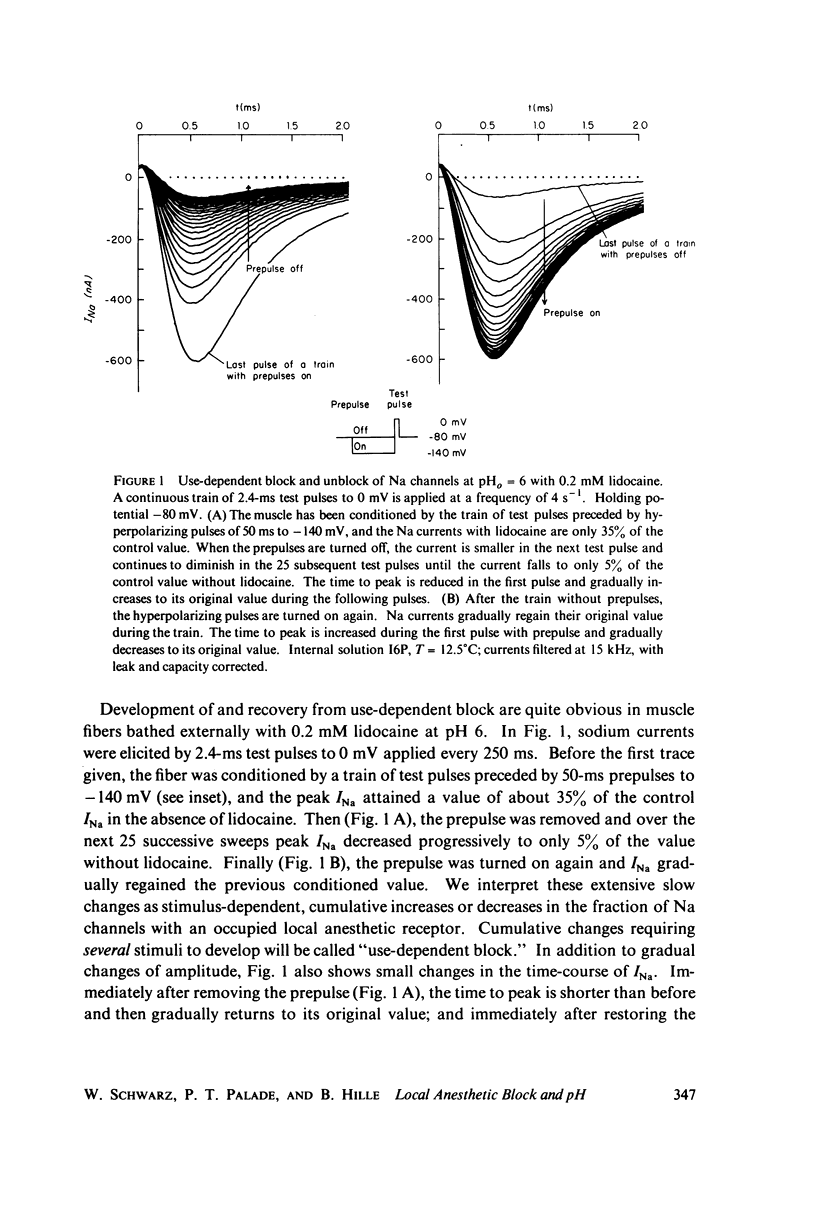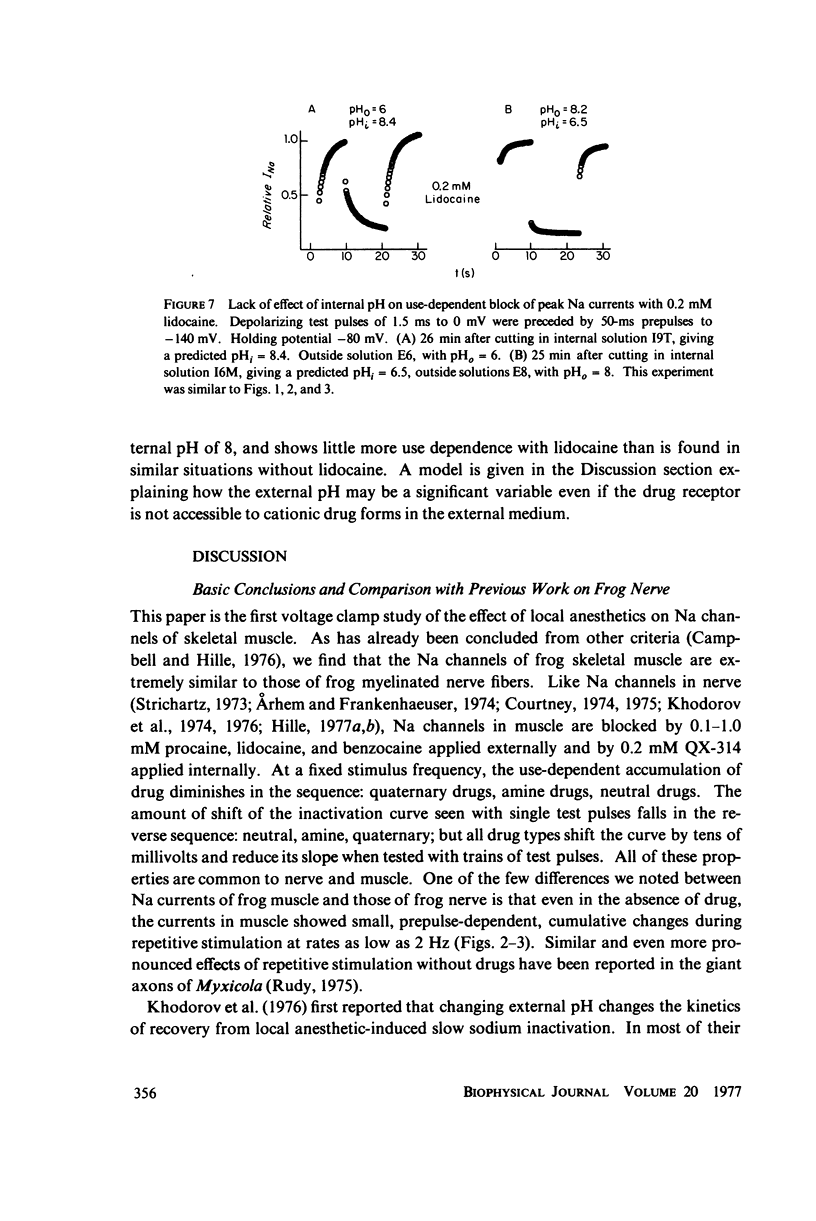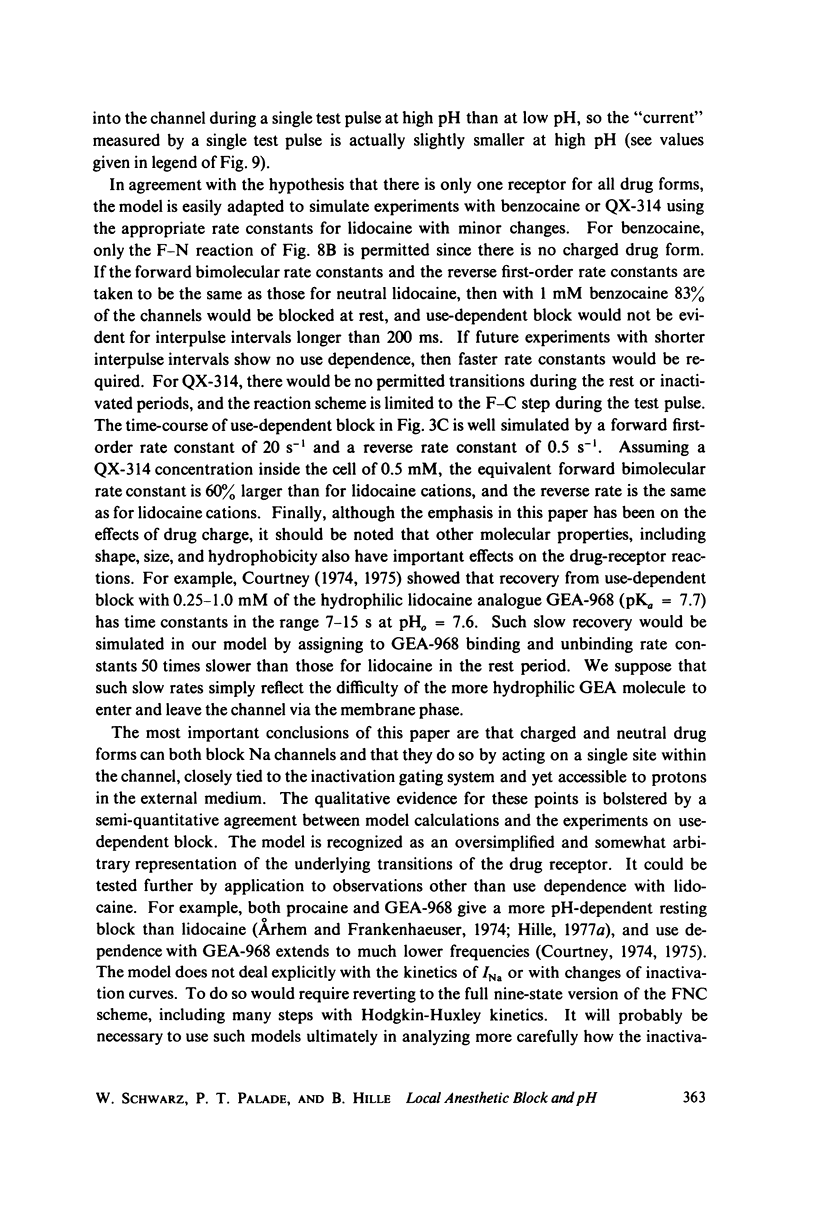Abstract
Sodium currents were studied under voltage clamp in the presence of neutral, amine, and quaternary local anesthetic compounds. Use-dependent block was observed as a cumulative depression of INa seen with repetitive depolarizing test pulses applied at frequencies of 2-10s-1. With quaternary QX-314, the time constant of use dependence was long, and with neutral benzocaine, very short. With lidocaine and procaine, increasing external pH (pHo) changed the time constant from long to short, but alterations of internal pH have no effect. Inactivation in Na channels was measured by the influence of prepulses on peak INa during test pulses. Single-stimulus inactivation curves were shifted more with lidocaine at high pHo than at low pHo, but inactivation curves measured during pulse trains with any of the drugs and at any pHo were strongly shifted. All measurements show that the drug-receptor reaction was slow for amine drugs at low pHo, as for quaternary drugs at any pHo, and fast for amine drugs at high pHo, as for neutral drugs at any pHo. The major effect of low pHo on amine drugs was to reduce the concentration of drugs in the fiber and to protonate drug molecules on the receptor, thus trapping them in the blocking position for a longer time. Direct effects of pH on the receptor seemed minimal.
Full text
PDF

























Selected References
These references are in PubMed. This may not be the complete list of references from this article.
- ADRIAN R. H. Potassium chloride movement and the membrane potential of frog muscle. J Physiol. 1960 Apr;151:154–185. [PMC free article] [PubMed] [Google Scholar]
- Arhem P., Frankenhaeuser B. Local anesthetics: effects on permeability properties of nodal membrane in myelinated nerve fibres from xenopus. Potential clamp experiments. Acta Physiol Scand. 1974 May;91(1):11–21. doi: 10.1111/j.1748-1716.1974.tb05652.x. [DOI] [PubMed] [Google Scholar]
- Campbell D. T., Hille B. Kinetic and pharmacological properties of the sodium channel of frog skeletal muscle. J Gen Physiol. 1976 Mar;67(3):309–323. doi: 10.1085/jgp.67.3.309. [DOI] [PMC free article] [PubMed] [Google Scholar]
- Colquhoun D., Henderson R., Ritchie J. M. The binding of labelled tetrodotoxin to non-myelinated nerve fibres. J Physiol. 1972 Dec;227(1):95–126. doi: 10.1113/jphysiol.1972.sp010022. [DOI] [PMC free article] [PubMed] [Google Scholar]
- Courtney K. R. Mechanism of frequency-dependent inhibition of sodium currents in frog myelinated nerve by the lidocaine derivative GEA. J Pharmacol Exp Ther. 1975 Nov;195(2):225–236. [PubMed] [Google Scholar]
- DESMEDT J. E. Electrical activity and intracellular sodium concentration in frog muscle. J Physiol. 1953 Jul;121(1):191–205. doi: 10.1113/jphysiol.1953.sp004940. [DOI] [PMC free article] [PubMed] [Google Scholar]
- DETTBARN W. D. The active form of local anesthetics. Biochim Biophys Acta. 1962 Feb 12;57:73–76. doi: 10.1016/0006-3002(62)91079-x. [DOI] [PubMed] [Google Scholar]
- Dettbarn W. D., Heilbronn E., Hoskin F. C., Kitz R. The effects of pH on penetration and action of procaine 14C, atropine 3H, n-butanol 14C and halothane 14C in single giant axons of the squid. Neuropharmacology. 1972 Sep;11(5):727–732. doi: 10.1016/0028-3908(72)90082-2. [DOI] [PubMed] [Google Scholar]
- EIGEN M., HAMMES G. G. ELEMENTARY STEPS IN ENZYME REACTIONS (AS STUDIED BY RELAXATION SPECTROMETRY). Adv Enzymol Relat Areas Mol Biol. 1963;25:1–38. doi: 10.1002/9780470122709.ch1. [DOI] [PubMed] [Google Scholar]
- Ellis D., Thomas R. C. Direct measurement of the intracellular pH of mammalian cardiac muscle. J Physiol. 1976 Nov;262(3):755–771. doi: 10.1113/jphysiol.1976.sp011619. [DOI] [PMC free article] [PubMed] [Google Scholar]
- Frazier D. T., Narahashi T., Yamada M. The site of action and active form of local anesthetics. II. Experiments with quaternary compounds. J Pharmacol Exp Ther. 1970 Jan;171(1):45–51. [PubMed] [Google Scholar]
- Good N. E., Winget G. D., Winter W., Connolly T. N., Izawa S., Singh R. M. Hydrogen ion buffers for biological research. Biochemistry. 1966 Feb;5(2):467–477. doi: 10.1021/bi00866a011. [DOI] [PubMed] [Google Scholar]
- HODGKIN A. L., HUXLEY A. F., KATZ B. Measurement of current-voltage relations in the membrane of the giant axon of Loligo. J Physiol. 1952 Apr;116(4):424–448. doi: 10.1113/jphysiol.1952.sp004716. [DOI] [PMC free article] [PubMed] [Google Scholar]
- Heisler N., Piiper J. The buffer value of rat diaphragm muscle tissue determined by P CO2 equilibration of homogenates. Respir Physiol. 1971 Jun;12(2):169–178. doi: 10.1016/0034-5687(71)90050-8. [DOI] [PubMed] [Google Scholar]
- Henderson R., Ritchie J. M., Strichartz G. R. The binding of labelled saxitoxin to the sodium channels in nerve membranes. J Physiol. 1973 Dec;235(3):783–804. doi: 10.1113/jphysiol.1973.sp010417. [DOI] [PMC free article] [PubMed] [Google Scholar]
- Hille B., Campbell D. T. An improved vaseline gap voltage clamp for skeletal muscle fibers. J Gen Physiol. 1976 Mar;67(3):265–293. doi: 10.1085/jgp.67.3.265. [DOI] [PMC free article] [PubMed] [Google Scholar]
- Hille B. Local anesthetics: hydrophilic and hydrophobic pathways for the drug-receptor reaction. J Gen Physiol. 1977 Apr;69(4):497–515. doi: 10.1085/jgp.69.4.497. [DOI] [PMC free article] [PubMed] [Google Scholar]
- Hille B. The pH-dependent rate of action of local anesthetics on the node of Ranvier. J Gen Physiol. 1977 Apr;69(4):475–496. doi: 10.1085/jgp.69.4.475. [DOI] [PMC free article] [PubMed] [Google Scholar]
- Izutsu K. T. Intracellular pH, H ion flux and H ion permeability coefficient in bullfrog toe muscle. J Physiol. 1972 Feb;221(1):15–27. doi: 10.1113/jphysiol.1972.sp009735. [DOI] [PMC free article] [PubMed] [Google Scholar]
- Kushmerick M. J., Podolsky R. J. Ionic mobility in muscle cells. Science. 1969 Dec 5;166(3910):1297–1298. doi: 10.1126/science.166.3910.1297. [DOI] [PubMed] [Google Scholar]
- SKOU J. C. Local anesthetics. I. The blocking potencies of some local anesthetics and of butyl alcohol determined on peripheral nerves. Acta Pharmacol Toxicol (Copenh) 1954;10(3):281–291. doi: 10.1111/j.1600-0773.1954.tb01344.x. [DOI] [PubMed] [Google Scholar]
- Strichartz G. R. The inhibition of sodium currents in myelinated nerve by quaternary derivatives of lidocaine. J Gen Physiol. 1973 Jul;62(1):37–57. doi: 10.1085/jgp.62.1.37. [DOI] [PMC free article] [PubMed] [Google Scholar]
- TAYLOR R. E. Effect of procaine on electrical properties of squid axon membrane. Am J Physiol. 1959 May;196(5):1071–1078. doi: 10.1152/ajplegacy.1959.196.5.1071. [DOI] [PubMed] [Google Scholar]
- WEIDMANN S. Effects of calcium ions and local anesthetics on electrical properties of Purkinje fibres. J Physiol. 1955 Sep 28;129(3):568–582. doi: 10.1113/jphysiol.1955.sp005379. [DOI] [PMC free article] [PubMed] [Google Scholar]
- Wagner H. H., Ulbricht W. Saxitoxin and procaine act independently on separate sites of the sodium channel. Pflugers Arch. 1976 Jun 29;364(1):65–70. doi: 10.1007/BF01062913. [DOI] [PubMed] [Google Scholar]
- Woodhull A. M. Ionic blockage of sodium channels in nerve. J Gen Physiol. 1973 Jun;61(6):687–708. doi: 10.1085/jgp.61.6.687. [DOI] [PMC free article] [PubMed] [Google Scholar]


